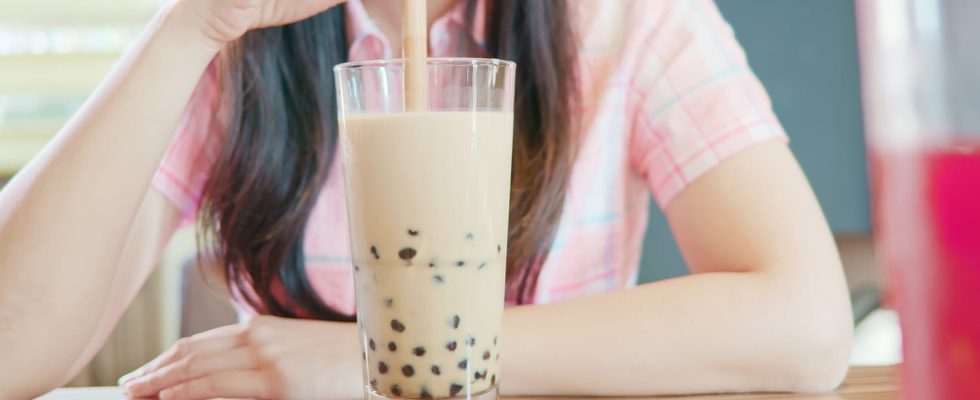A trendy drink made from tea and tapioca pearls, bubble tea is not very good for your health. Recently associated with symptoms of depression, it is also very sweet.
Came from Taiwan, THE bubble tea is a beverage trend in France. But be careful of fashion effects! Originally composed of tea, milk and tapioca pearls. bubble tea seems “healthy”. In reality, it is so revisited that it can become a sugar mine ! Other harm (to be confirmed): according to a study published in the Journal of Affective Disorders in 2023conducted among 5,281 students in Beijing (China), this type of tea and milk-based drinks could cause dependence among consumers and associated with symptoms of depression, anxiety and even suicidal thoughts.
What is bubble tea? What origin ?
“Bubble tea” in English means “bubble tea” in French. Bubble tea (“zhenzhu naicha” in Taiwanese) is a drink born in Taiwan In the 1980’s, made from tea, tapioca pearls (originally) and fruit. It is also called “bubble tea“ Or “Boba Tea.” It is drunk hot or cold and is generally eaten to take away. The pearls are sucked up using a straw with a large diameter. In Taiwan, it is almost the national drink. In Franceit is more and more popular and its success continues to grow, particularly in the big cities. This drink is generally sold at a price ranging between 5 to 7 euros.
What is the composition of bubble tea?
Originally, it was a tea-based drink in which tapioca pearls (starch extracted from cassava starch) or pieces of fruit were incorporated. Over the years, the bubble tea recipe has evolved: the tapioca pearls are lightly covered with Brown sugar or syrup (hence their brown color), and we now find milk, syrups with artificial colors, flavored powders (tarobanana, chai…), gummy fruit pearlsand sometimes even whipped cream.
How many calories in bubble tea?
THE sweetened bubble tea (without milk) contains approximately 116 kcal per 100 ml (source: Ciqual table, Anses). So a 350 ml cup would contain approximately 350 calories.
| Beverage | Calories (per 100 ml) |
|---|---|
| Bubble tea | 116 |
| Coca-Cola | 44 |
| Milkshake | 110 |
| Iced tea | 35 |
What are the dangerous effects of bubble tea?
A risk of digestive pain or constipation because of tapioca pearls
“Like all sugary drinks, consuming them without moderation is not healthy“, indicates our interlocutor. According to our expert, consuming too much bubble tea can lead to:
- A exciting effect : “Bubble tea contains theine (tea is the main ingredient of bubble tea) which is a stimulant”recalls our interlocutor.
- A heightened risk of overweight or obesity, as part of a high-calorie diet and without associated physical activity.
- A want to consume even more sugar. “On the other hand, the term sugar addiction is not appropriate because stopping sugar does not cause withdrawal symptoms.“.
- Digestive pain or constipation from tapioca pearls
- “Scientific literature has highlighted some of the harms of bubble tea. There have been reported cases of very severe gout attacks when the drink was drunk in excess“, specifies the nutritionist.
Amount of sugar in bubble tea
A study, commissioned by Channel NewsAsia and conducted by food science and nutrition students at Temasek Polytechnic, assessed the amount of sugar in these drinks. Results :
“Experts have warned that a lack of knowledge on the amount of sugar contained in each cup of bubble tea could mislead people making them believe that it’s healthier than soft drinks“, indicate the authors of the study. Like any sweet product, if consumption remains occasional, there is no health problem. On the other hand, if consumption is too frequent, bubble tea presents a risk.
Does bubble tea make you gain weight?
Yes, like all sweet drinks. The sweetest versions of bubble tea may contain more sugar than some soft drinks such as sodas. Generally, the marketed size of bubble tea is 400 to 500 ml, and a quantity of 500 ml of sweetened bubble tea contains approximately 92 g of sugar“either about three times more than the amount of sugar contained in a cola soda“, points out Dr. Ziyadi.
Is bubble tea chemical?
“Originally, this Taiwanese drink was composed mainly of green tea or black tea, tapioca pearls and milk. It was not a chemical drink. Over the past 2-3 years, it has been popularized in France , particularly among adolescents, and has become somewhat Europeanized with the addition of syrups, even artificial colorings, additives, gelling agents and flavorings…”, lists the specialist. However, like all food products, the longer the list of ingredients, the less natural the composition.
Does bubble tea contain gluten?
The pearls contained in bubble tea are tapioca pearls and are gluten-free.
Limit bubble tea consumption to two or three per month.
“To date, there are no official recommendations regarding the consumption of drinks such as bubble tea. However, as with all sugary drinks, as long as consumption is timely, there are no particular health dangers. We can still enjoy eating it from time to time. If consumption becomes excessive or even daily, there is a health risk“, specifies Dr. Ziyadi. To limit the risks and have more reasoned consumption, here are some reflexes to adopt:
- Opt for lower amounts of sugar as far as possible (the stores offer to reduce the quantity of added sugar: 0%, 30%, 50% or 100%).
- Choose the smallest cup size.
- Limit bubble tea consumption to two or three per montheven if “Unfortunately, we cannot scientifically specify a rate of consumption at this time. Each person has a different profile“
Thanks to Dr Asmahan Ziyadi, nutritionist at the Saint-Amé Clinic (Ramsay Santé).
